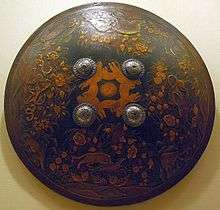Dhal Shield

The Dhal Shield is a type of hand-held shield that originated in India, then later spread to Persia (sipar) and other countries in between. They are nearly always round and varies in diameter from about eight inches to twenty four inches. Some Dhal shields are nearly flat while others are strongly convex, or curved.[1] The edges may be flat or rolled back in the reverse direction to that of the curvature of the shield. They were made from animal hide or occasionally steel. The steel shields are usually inlaid with silver and gold, though on some occasions they are covered with inscriptions.[2]
It is held by two handles fastened to ring bolts that pass through the shield and are riveted to bosses on the outside. Between the handles there is a square cushion for the knuckles to rest against. The handles are so placed that, when tightly grasped, they force the backs of the fingers against the cushion giving a very firm and comfortable hold. Some Persian shields have three handles, two placed at the center as usual, and the third near the edge. The arm can be passed through the third loop and the center handles held in the hand; or it can be held by the center handles only.
The steel shields are usually inlaid with gold, silver and precious stones. The entire surface is sometimes covered with inscriptions. The hide shields are decorated with gilding and painting, the best with lac. The bosses are always ornamental, either by their shape alone, or through inlaying with gold, silver and jewels. The metal shields are lined generally with velvet, sometimes embroidered with colors, gold or silver. Shields were formerly made in Persia of concentric rings of cane covered with silk threads woven on in patterns. Most of those we know were captured at Vienna after the siege by the Turks.[3]
Collections
Within the Ethnography gallery at Horsham Museum, Horsham, West Sussex, United Kingdom, there are three Dhal shields on display. From left to right on the panel:
- Hide Dhal from Afghanistan. According to a label on the back, it was bought on 27 November 1923for six shillings at Cold Ashby Hall sale.
- Hide Dhal with brass edge from Bhutan. Bhutan is a kingdom in central Asia that has been disputed over by Tibet, China, India and Britain since the 18th century. It contains inaccessible stretches of the eastern Himalayas to the north.
- Metal Dhal dating from the 19th century and has a script running around the outside and etchings of animal and facial markings in the central area.
The Misses Hoper of Cowfold donated both the large shields in 1947 along with a number of other weapons. The central shield came from the Godman family of Storrington who might be connected to the Godman's of Lower Beeding, a well known family of collectors.
References
- ↑ Cameron Stone, George (1961). A GLOSSARY of the Construction, Decoration and Use of Arms and Armor IN ALL COUNTRIES AND IN ALL TIMES Together with Some Closely Related Subjects. Jack Brussel. p. 206.
- ↑ Horsham Museum Website
- ↑ Cameron Stone, George (1961). A GLOSSARY of the Construction, Decoration and Use of Arms and Armor IN ALL COUNTRIES AND IN ALL TIMES Together with Some Closely Related Subjects. Jack Brussel. p. 207.
External links
| Wikimedia Commons has media related to Dhal. |
- Horsham Museum website with collections database access